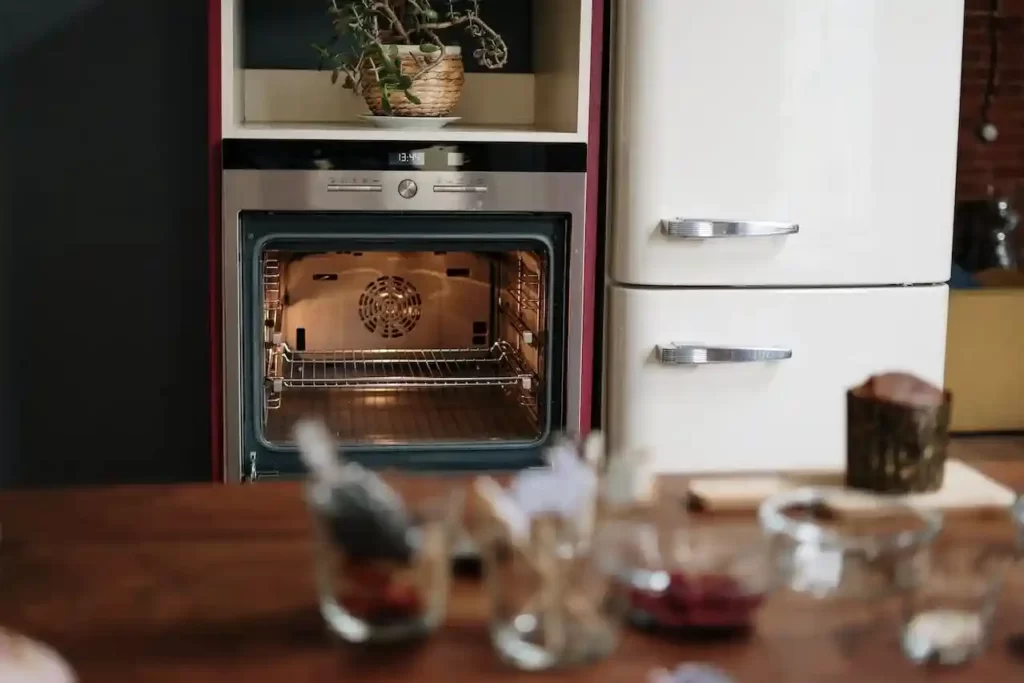Convection ovens and conventional ovens are two popular choices in both commercial and home kitchens, each offering distinct cooking techniques and results. While they may appear similar at first glance, these two types of ovens operate quite differently, impacting everything from cooking time to the texture of the food. Understanding the key differences between convection and conventional ovens is crucial for anyone looking to make an informed decision about which is best suited to their culinary needs. Before moving to difference first get to know about each oven and features.
What is Convection Oven?

A convection oven represents a modern cooking appliance designed to enhance efficiency and consistency in baking or roasting. What sets it apart is its specialized fan and exhaust system. This system circulates hot air inside the oven, ensuring even distribution of temperature. This consistent heat circulation reduces cook times, saves energy, and cooks food more evenly. Convection ovens are particularly favored for their ability to achieve a perfect, uniform brown on baked goods and crispier skins on meats. They’ve become a staple in many UK kitchens for their versatility and improved cooking performance.
What is Conventional Oven?

In contrast to its convection counterpart, a conventional oven relies on stationary heat sources, typically located at the top and bottom of the oven cavity. These ovens are the traditional choice in many homes and have been the backbone of domestic baking and roasting for generations. In a conventional oven, heat radiates upwards and downwards, creating zones of varying temperatures. This can lead to uneven cooking or baking, a challenge that requires manual intervention, like rotating pans. However, conventional ovens are still widely used due to their simplicity and suitability for a wide range of recipes.
Convection vs Conventional Oven – Key Differences Explained
When delving into the debate of conventional vs convection ovens, several distinct differences stand out, each playing a pivotal role in cooking and baking experiences. Here’s a detailed look at these differences:
1. Heating Method and Distribution
The most significant difference lies in their heating methods. Convection ovens are equipped with a fan and exhaust system that circulates hot air around the food. This results in an even and consistent cooking environment. In contrast, conventional ovens use stationary heat sources, typically at the top and bottom of the oven. This can lead to hot spots and uneven cooking, requiring more attention during cooking.
2. Cooking Time and Efficiency
Due to the efficient circulation of heat, convection ovens generally cook food faster than conventional ovens. This can translate to a reduction in cooking time by up to 25%. The quicker cooking time not only saves energy but can also be a significant time-saver in a busy kitchen.
3. Temperature Control and Consistency
Convection ovens often provide a more consistent and precise temperature throughout the cooking process. This control helps in avoiding the under or overcooking of food, which is a common issue in conventional ovens due to their uneven heat distribution.
4. Suitability for Different Foods
While convection ovens are versatile, they may not be ideal for all types of food. For instance, baked goods like soufflés or delicate pastries might not fare well with the fan circulation. Conventional ovens, with their static heat, can sometimes be more suitable for these delicate baking tasks.
5. Energy Consumption and Efficiency
Generally, convection ovens are more energy-efficient. They cook food faster and at lower temperatures compared to conventional ovens. This efficiency can lead to reduced energy bills and a smaller carbon footprint, an important consideration for environmentally conscious consumers.
6. Physical Structure and Maintenance
Convection ovens can be slightly more complex in design due to their additional components like fans. This might mean a higher initial cost and potentially more maintenance compared to the simpler design of conventional ovens.
7. Learning Curve and Adaptability
There’s a learning curve when transitioning from a conventional to a convection oven, especially in adapting recipes and cooking times. Users should adapt to the quicker cooking times and learn how the fan influences various food items.
8. Price Point and Availability
Typically, convection ovens are more expensive than their conventional counterparts, reflecting their advanced technology. However, the investment can be worthwhile for avid cooks and bakers looking for efficiency and consistency in their cooking.

When to Use a Convection Oven
Choosing a convection oven can enhance your cooking experience in specific scenarios:
Roasting Meats and Vegetables: The even heat distribution in a convection oven is ideal for roasting meats and vegetables. It ensures a perfectly browned exterior while retaining moisture inside, making it perfect for succulent roasts and crispy vegetables.
Baking Multiple Trays: If you’re baking multiple trays of cookies or pastries, a convection oven ensures uniform cooking across all trays, without the need to rotate them mid-bake.
Cooking Large Meals: For large gatherings where multiple dishes need to be cooked simultaneously, a convection oven provides consistent heat distribution, ensuring all dishes are cooked evenly.
Dehydrating Foods: The circulating air in a convection oven makes it excellent for dehydrating fruits and vegetables evenly and efficiently.
Quick Cooking: When time is of the essence, the convection oven’s ability to cook food faster than conventional ovens is a significant advantage.
You may also like to Read: What Colours Go with Cashmere Kitchen Units
When to Use a Conventional Oven
Conventional ovens, with their unique cooking qualities, are better suited for certain cooking tasks:
Baking Delicate Cakes and Pastries: Delicate baked goods like soufflés, flans, and some pastries can benefit from the stationary heat of a conventional oven, which doesn’t disturb the batter’s structure.
Slow Cooking Dishes: Dishes that benefit from slow cooking, like casseroles, can be better prepared in a conventional oven, where the heat envelopes the dish gently over time.
Cooking with Specific Bakeware: If you’re using bakeware that’s not compatible with the fan and exhaust system of a convection oven, such as certain types of foil or lightweight pans, a conventional oven is the safer choice.
Traditional Recipes: For recipes that were specifically developed for conventional ovens, sticking to this type of oven can yield more predictable and traditional results.
Budget Cooking: If budget constraints are a concern, conventional ovens are typically more affordable and offer a straightforward cooking process without the need for adjustments in cooking time and temperature.
Conclusion
In conclusion, the choice between a convection oven and a conventional oven depends largely on your cooking needs, preferences, and the types of dishes you frequently prepare. Convection ovens, with their advanced technology of circulating hot air, offer efficiency, even cooking, and time savings, making them ideal for roasting, baking multiple trays, and quick cooking. On the other hand, conventional ovens, with their traditional stationary heat source, are better suited for baking delicate pastries, slow-cooked dishes, and when working with specific types of bakeware.







